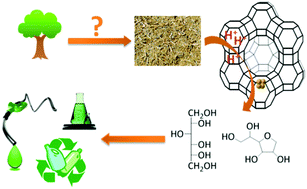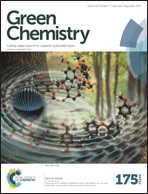The importance of pretreatment and feedstock purity in the reductive splitting of (ligno)cellulose by metal supported USY zeolite†
Abstract
Reductive hydrolysis of cellulose to hexitols is a promising technology to valorize cellulose streams. Several catalytic systems have been reported to successfully process commercially available purified cellulose powders according to this technology. Ruthenium-loaded USY zeolites in the presence of minute amounts of HCl previously showed very high hexitol yields. This contribution first investigates into more detail the impact of several cellulose accessibility-related properties like cellulose crystallinity, particle size and degree of polymerization on the conversion rate and hexitol selectivity. Therefore, a series of commercial cellulose samples and several mechano- and chemotreated ones were processed with the Ru/H-USY–HCl catalytic system under standard hot liquid water conditions. The results reveal that the polymerization degree has a large impact on both the conversion rate and selectivity, but its impact fades for DPs lower than 200. From then on, the dominant parameters are the particle size and crystallinity. A second part addresses the influence of cellulose purity. Therefore, organosolv pulps of three lignocellulosic substrates (wheat straw, spruce and birch wood), optionally followed by a bleaching procedure, were processed under the same catalytic circumstances. Here factors like residual lignin content and acid buffer capacity appeared crucial, pointing to the necessity of a dedicated delignification and purification procedure step in order to form the most reactive cellulose feedstock for hexitol production. Complete removal of non-glucosic components is not required since processing of ethanol organosolv birch cellulose and bleached ethanol organosolv wheat straw cellulose, both containing about 6 wt% of lignin and minor contents of ashes and proteins, showed a similar hexitol yield, viz. 34–39%, to that derived from pure microcrystalline cellulose.

- This article is part of the themed collection: 3rd International Symposium on Green Chemistry

 Please wait while we load your content...
Please wait while we load your content...